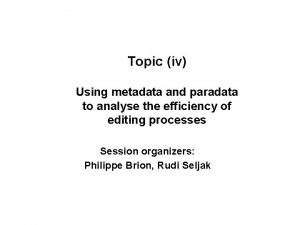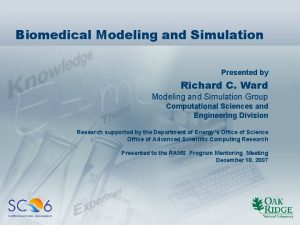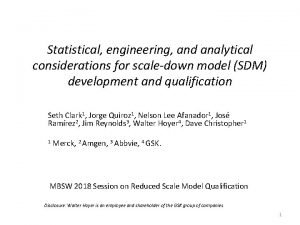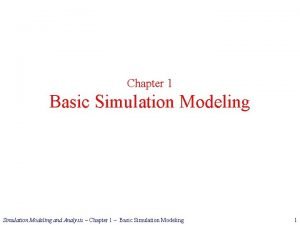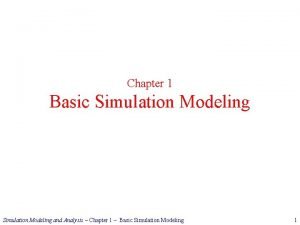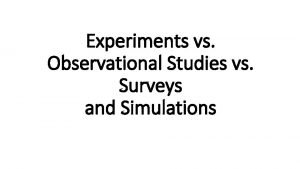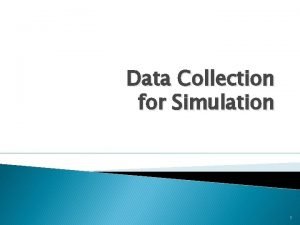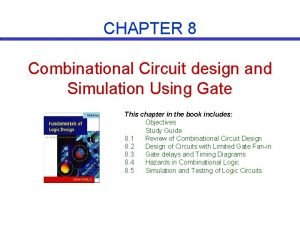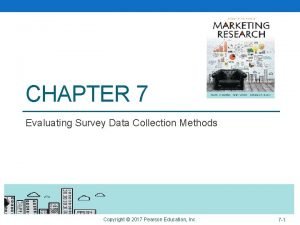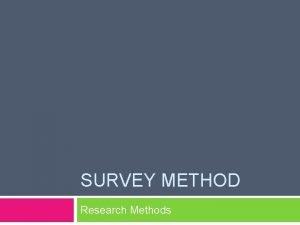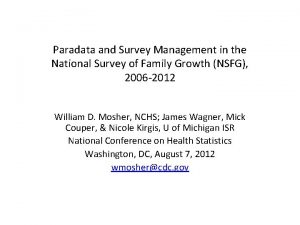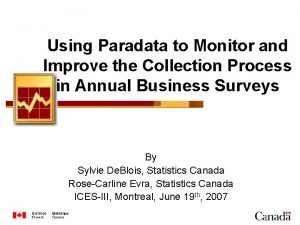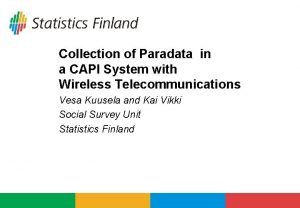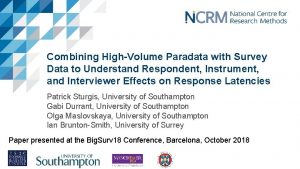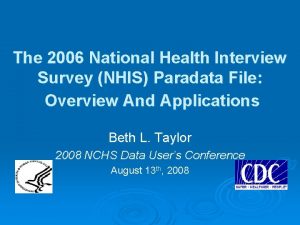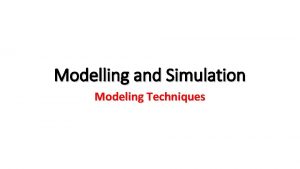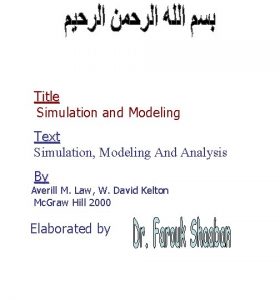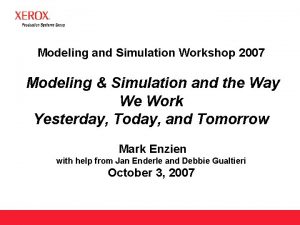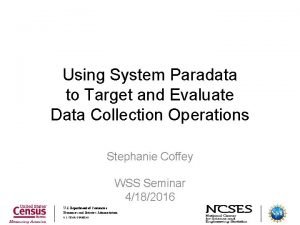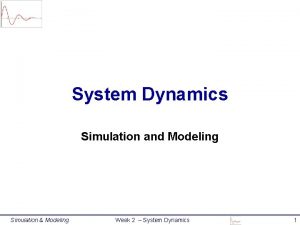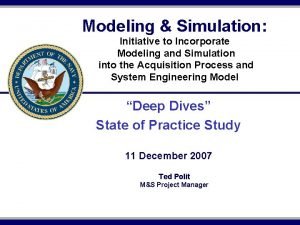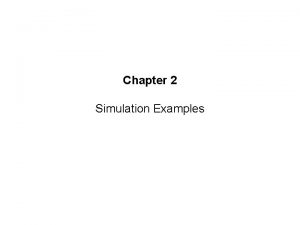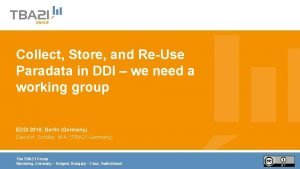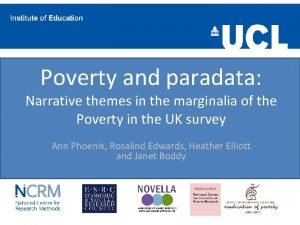Modeling and Simulation of Survey Collection Using Paradata



















- Slides: 19

Modeling and Simulation of Survey Collection Using Paradata Presented by: Kristen Couture Co-authored by: Yves Bélanger Elisabeth Neusy

Outline 2 Motivation for Simulating Survey Collection Details of Simulation Modeling using Paradata Preliminary Results Conclusions Future Work

Motivation Ultimate goal: make CATI survey collection more efficient Recent initiatives in the field • Experimentation with call attempts and calling priorities • Takes time, lack of control, costly, results not always easy to interpret Need for a controlled environment, where impact of each experiment can be tested prior to collection 3

Microsimulation What is microsimulation? • A modeling technique that operates at the level of individual units, such as persons, households, vehicles, etc. For us: microsimulation = a "virtual collection" system Recreates CATI collection environment with Simulation Software (SAS Simulation Studio) Allows manipulation of parameters in simulated environment 4

Microsimulation What are the elements of our microsimulation? • • • 5 Cases Queues Interviewers Rules of the Call Scheduler (flows and priorities) Output Call Transaction File

Overview of Microsimulation SAS Simulation Studio Paradata Model Call Outcomes Model Call Duration Model Parameters Simulation Model Collection Parameters 6

Modeling using Paradata Use existing survey data (Blaise Transaction History) Call Outcome • Multinomial logistic regression Call Duration • Create histograms and fit distributions for each of the outcomes Output Model parameters • Estimated parameters from logistic regression model • Fitted distribution and parameters • Input into simulation model 7

Multinomial Logistic Regression Modeling using Paradata: Call Outcome 8 Model probability of outcomes (sum of probabilities = 1) k+1 outcomes xi = explanatory variables from paradata pj = probability of outcome j = parameters from logistic regression model

Modeling Call Outcome: An Example Paradata: Existing RDD survey 5 outcomes: Unresolved, Out of Scope, Refusal, Other Contact, Respondent 7 explanatory variables entered into the model Time of Call: Afternoon, Evening, Weekend Residential Status: Residential phone number Call history: Unresolved, Refusal, Contact Estimated parameters from model are entered into simulation 9

Modeling Call Outcome: An Example Calculate probability of each outcome Time of Call History pj values 10

Microsimulation Paradata Model Call Outcomes Model Call Duration Model Parameters Simulation Model Collection Parameters 11

Preliminary Results: Two examples Investigate how collection parameters impact response rates Two Examples: • Example 1 : Different distributions of interviewers throughout the day • Example 2: Different distributions of interviewers throughout the day combined with different time slices Purpose: • Demonstrate how users can manipulate collection parameters to test specific collection scenarios • Verify that simulation results reflect collection 12

Example 1 Change allocation of interviewers throughout the time periods One Possible Scenario Time period Morning # of Interviewers 4 3 Time Periods each 4 hours in length (9 h-13 h) 30 interviewers per day for 30 days Afternoon (13 h-17 h) 4 What happens to response rates? Evening (17 h-21 h) 22 Fixed Total 30 13

Example 1 14

Example 2 Same setup as Example 1 One Possible Scenario Add time slices: control maximum number of attempts made at different time periods throughout the day Time period # of Interviewers Max # of Attempts Morning 4 2 Afternoon 4 2 What happens to response rates? Evening 22 16 Fixed Total 30 20 15

Example 2 Response Rates 16

Conclusions Create simple simulation model using paradata that produces results that reflect collection Able to test different collection parameters to see impact on response rates without spending a lot of money or time Approach adaptable to all types of CATI surveys 17

Future Work Improve logistic model by adding more parameters Add more complicated collection procedures to the model such as interviewer characteristics Simulate collection with multiple surveys at a time to see impact Run simulation for a survey to predict outcome and compare with actual results from field 18

For more information, please contact: Pour plus d’information, veuillez contacter : Kristen Couture kristen. couture@statcan. gc. ca Yves Bélanger yves. belanger@statcan. gc. ca Elisabeth Neusy elisabeth. neusy@statcan. gc. ca 19
 Paradata vs metadata
Paradata vs metadata Role modeling theory
Role modeling theory Simulation modeling and analysis law kelton
Simulation modeling and analysis law kelton Pharmaceutical simulation and modeling
Pharmaceutical simulation and modeling Introduction to modeling and simulation
Introduction to modeling and simulation Biomedical modeling and simulation
Biomedical modeling and simulation Simulasi
Simulasi Site:slidetodoc.com
Site:slidetodoc.com Relational modeling vs dimensional modeling
Relational modeling vs dimensional modeling Nature of simulation
Nature of simulation Basic simulation modeling
Basic simulation modeling Observational study vs survey
Observational study vs survey Simulation data collection
Simulation data collection Combinational circuit design and simulation using gates
Combinational circuit design and simulation using gates Combinational circuit design and simulation using gates
Combinational circuit design and simulation using gates Acls abcde secondary survey
Acls abcde secondary survey What is self administered survey
What is self administered survey Bruso survey
Bruso survey Landsat collection 1 vs collection 2
Landsat collection 1 vs collection 2 D/a 30 days after sight
D/a 30 days after sight
